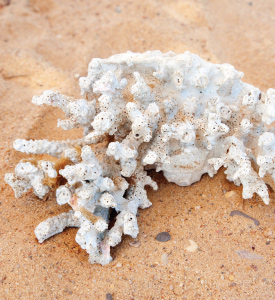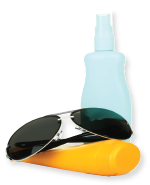Sunscreen and coral reefs
by Laura Brady
This article was originally published in July 2016

Anyone can tell you the difference a drop of sunscreen can make: many of us have missed slathering some on a patch of skin and ended up with a painful, red tattoo for a few days. But for corals, the difference can mean life or death.
A recent study in the Archives of Environmental Contamination and Toxicology reveals that oxybenzone, a chemical found in more than 3,500 sunscreens worldwide, may partly be responsible for coral reef bleaching — and all it takes is a drop. The study found that the equivalent of a water drop of sunscreen in a body of water the size of six Olympic-sized swimming pools was enough to cause damage to the delicate organisms in coral.
Corals get their color from microscopic algae that live in their tissues in an important symbiotic relationship. When corals are under stress from temperature changes and pollution, such as from chemicals in body care products, they expel the algae — a major food source — and with it lose their vibrant colors. Bleaching often proves lethal to corals, causing reefs to degrade, along with the important habitats they provide for fish and other wildlife.
This habitat is valuable for more than its contributions to tourism — a billion-dollar industry of its own. According to the National Oceanic and Atmospheric Administration (NOAA), the value of coral reefs to fisheries is $100 million, as coral reefs provide spawning habitat for the fish we eat and protect large portions of the coast from storm surge. The NOAA website says, “Globally, coral reefs provide a net benefit of $9.6 billion each year from tourism and recreation revenues, and $5.7 billion per year from fisheries.”
In other words, if we damage coral reefs, we lose more than beautiful snorkeling.
Ironically, snorkeling is one of numerous ways sunscreen makes its way to coral reefs. In high-tourist areas, the “oil slick” left behind from swimmers is a main contributing factor. But even away from coastal areas, everyone eventually goes home and takes a shower, and any sunscreen left on the skin makes its way into wastewater, which in many cases gets funneled into the ocean and coral habitats.
Better options
The effect of sunscreen on coral reefs adds just another component to the already complex decisions consumers face when trying to pick a sunscreen. Buzzwords in recent years such as “full-spectrum” and “nanoparticles,” and the onslaught of SPF options, can overwhelm even the most-informed shopper. While there’s no perfect sunscreen option, following a few basic guidelines can maximize health benefits and minimize ecological harm.
First, for coral reef protection, consumers should avoid sunscreens with oxybenzone, butylparaben, octinoxate (ethylhexyl methoxycinnamate) and 4-methylbenzylidene camphor (4MBC). While this means excluding brands you’d find in mainstream stores — such as Coppertone, Baby Blanket Faces, L’Oreal Paris, Hawaiian Tropic and Banana Boat — there are many sunscreen options that don’t contain these chemicals. All sunscreens sold at PCC are free of such harmful synthetic ingredients.
Second, consumers should pick a sunscreen with mid-range SPF (15-30) and broad-spectrum protection. Higher SPF sunscreens do not provide additional protection from UVA rays, making their protective benefits somewhat misleading. More important than SPF is frequent and generous application. According to the Environmental Working Group (EWG), “most people put on only one-quarter to two-thirds as much as it takes to achieve the product’s SPF rating.” The advised amount is 1 ounce, or enough sunscreen to fill a shot glass.
Finally, consumers should think beyond sunscreen for sun protection. Despite continued growth in sunscreen use, rates of melanoma — the most lethal form of skin cancer — have tripled over the past three decades. Sunscreen can prevent sunburn, one cause of cancer, but it’s not a free pass to unrestricted sun time. The best sun protection is covering up with protective clothing, staying in the shade, and minimizing sun exposure from 10 a.m. to 4 p.m. when harmful rays are most prevalent.

Sunscreen in a splash
Broad-spectrum/UVA protection
All sunscreens protect against UVB rays, but it’s also important to protect against UVA, another form of ultraviolent radiation that causes cancer and premature skin aging. Pick a sunscreen with UVA protection.
Vitamin A
A common additive to sunscreens because of its anti-aging properties, vitamin A has been shown to increase the incidence of skin tumors. Choose a sunscreen without vitamin A.
Nanoparticles
Nanoparticles in zinc oxide and titanium dioxide-based sunscreens help reduce or eliminate the chalky white tint that these minerals once left on the skin. The jury’s still out on whether there’s an appreciable difference between nanoparticles and micronized ingredients (EWG says there isn’t), but in the meantime, PCC only sells sunscreens with micronized ingredients, not ingredients from nanotechnology.
Laura Brady is a freelance writer in Seattle.
